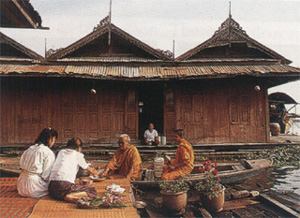|
|
|
The Land and Its People
|
Urban Values
Buddhism is at the centre of the
Thai view of life and forms the foundation
of most attitudes, in the city as well as in
the village. But just as even the toughest
material will change its shape under
pressure. Buddhism has undergone
certain alterations due to the stress of
Bangkok's fast-paced urban life style.
In the village the wat is the centre
of social as well as religious life.
Bangkok's monasteries today inevitably
play less of a social role and are normally
visited only for religious observances or
for one of the festivals scattered throughout
the Buddhist year. Accessibility is the
main problem; in the village the wat is
generally just a short walk away, while
in the city a visit often entails a long hot
trip in heavy traffic. Therefore, many
Bangkok homes have a room set aside
for family Buddha images and a small
altar. This little private sanctuary serves
as a place for prayers and meditation
in the morning and evening daily
rituals that in a village would be more
customarily performed at the wat.

Traditional life-styles are changing
|
Urban surroundings also rob many
monasteries of the tranquil atmosphere
which characterizes their rural counterpans,
Nevertheless, monks continue to practise
their meditation in them. seemingly
undisturbed by the bustling life outside,
just as they go out each morning to
collect food offerings from city dwellers
as anxious to make merit as villagers.
Many Bangkok residents also go to
them to study meditation during their time off from work.
Formerly, everyday life was highly
siruciured and circumscribed by
Brahmanic ritualistic taboos, and some
of these still linger in modem society.
Wednesday, for example, was believed
to be an inappropriate day on which to
cut hair and. accordingly, some Bangkok
barber shops close on that day.
Astrology also retains its ancient
influence and is used by many people
to determine auspicious dates for
major undertakings. Buddhist monks,
Brahmans, and professional astrologers
cast horoscopes according to which the
day and hour to embark on a trip are
decided. Purchasing land, starting a new
business, or opening a shop are also
often subject to an astrologer's calculations,
and few couples would agree to be
married without first determining the
suitability of their union and the most
auspicious day and minute for the ceremony.
Traditional Thai life-styles, which
survive virtually intact in upcountry
villages, have undergone extensive
reshaping under Ihe pressure of urban
demands. Family ties in the city, for
example, are not as pervasive as in the
village, and young married couples
often set up housekeeping on their own.
Unmarried youths also have much more
freedom in their daily life.
Modernization has greatly
expanded the range of employment
opportunities open to people migrating
to the city. Only a few decades ago,
virtually the only acceptable course
available to a newly-arrived girl from
the countryside was to take a position
as a domestic servant. Now she may
prefer a job in one of the light industries sorting transistors, assembling
pocket calculators, or working in one of
Bangkok's huge textile plants. An incidental effect of this development has
been the introduction of an increasing
number of labour-saving electrical
appliances into middle- and upper-class
homes. Once considered a wasteful
extravagance, washing machines,
vacuum cleaners, and microwave ovens
are now common household items
available in all department stores.
Despite all the apparent changes.
however, traditional Thai values are
slill strong beneath the surface of urban
life. even though they may be all but
invisible to an outsider. This is a reflection
of the fact that me overwhelming majority
of city dwellers have come from
village backgrounds and also of the
potent strength of the Thai cultural
heritage, which over the centuries has
so often demonstrated its ability to bend
without breaking.
| | |
|
|